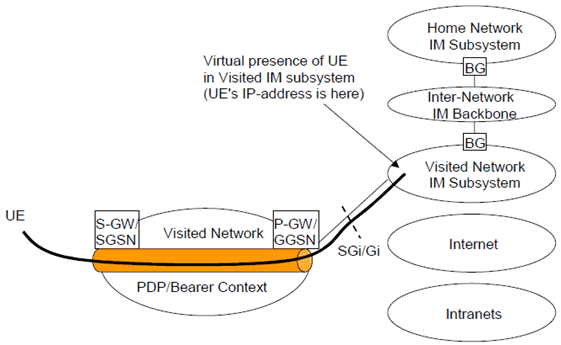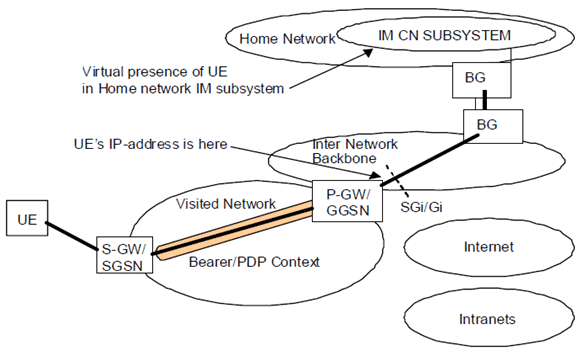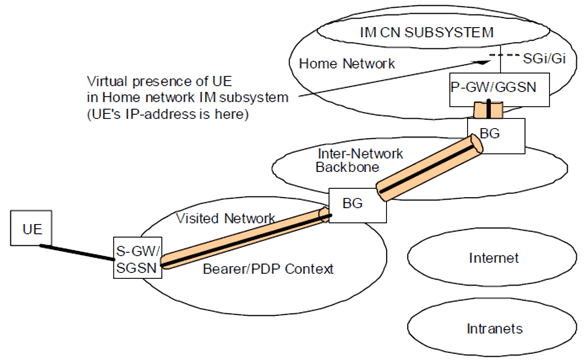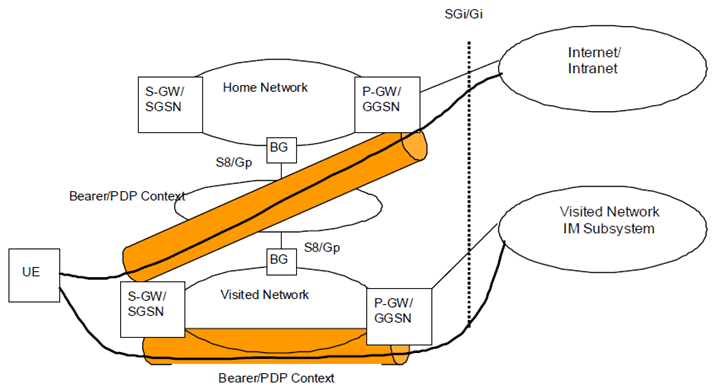Content for TS 23.221 Word version: 18.0.0
5.4 IP addressing and routing for access to IM-subsystem services
5.5 Simultaneous access to multiple services
5.6 UE support of IPv6
5.7 IP addressing and routing for server/application
...
...
5.4 IP addressing and routing for access to IM-subsystem services |R5| p. 16
This clause deals with a UE accessing IM CN subsystem services via EPS or GPRS.
A UE accessing IM CN Subsystem services requires an IP address that is logically part of the IM CN subsystem IP Addressing Domain. This is established using an appropriate PDP or EPS Bearer context. It is possible to connect to a P GW/GGSN either in the VPLMN or the HPLMN. For routing efficiency this context may benefit from being connected through a P GW/GGSN in the visited network. The connection between the UE and the IM CN subsystem (where the P GW/GGSN is either in the Home or the Visited network) is shown below:

Figure 5-5: UE Accessing IM Subsystem Services with P-GW/GGSN in the Visited network via Visited Network IM subsystem
(⇒ copy of original 3GPP image)
(⇒ copy of original 3GPP image)

Figure 5-5a.1: UE Accessing IM Subsystem Services with P-GW/GGSN in the Visited network
(⇒ copy of original 3GPP image)
(⇒ copy of original 3GPP image)

Figure 5-5a: UE Accessing IM CN subsystem Services with P-GW/GGSN in the Home network
(⇒ copy of original 3GPP image)
(⇒ copy of original 3GPP image)
The ability of the User plane and the Control Plane for a single IMS session being able to pass through different P GWs/GGSNs is not defined in this release.
5.5 Simultaneous access to multiple services |R5| p. 17
A UE can have multiple services active simultaneously. When the services are part of different IP addressing domains, separate EPS Bearer or PDP contexts and IP addresses are required. The UE shall support multiple IP addresses when simultaneous EPS Bearer or PDP contexts are activated that require separate IP addresses for different addressing domains.
Figure 5-6 shows an example of a connection between a UE and an Internet/Intranet service that is not available in the Visited Network with a simultaneous connection to the Visited Network's IM Subsystem. In this example, there may be two IPv6 addresses allocated, or one IPv4 address allocated for internet/Intranet access and oneIPv6 address for IM subsystem access.

Figure 5-6: UE Accessing Home Internet/Intranet Services and Visited Network IM CN Subsystem Services
(⇒ copy of original 3GPP image)
(⇒ copy of original 3GPP image)
5.6 UE support of IPv6 |R5| p. 18
The set of IPv6 functionality a 3GPP UE will require is dependent on the services (IMS, Packet Streaming etc.) it will use.
As a minimum, a 3GPP UE shall comply with the Basic IP group of specifications as defined in RFC 3316. This IPv6 functionality is sufficient to provide compatibility towards IPv6 entities external to 3GPP. The 3GPP UE should support RFC 4941 and it should use RFC 4941 when choosing an interface identifier to generate the full IPv6 address for the initial generation process.
A 3GPP UE shall follow the recommendations for the IP Security set of functions in RFC 3316 when a specific service requires such functions.
According to the procedures defined in TS 23.060 and in TS 23.401, when a UE is assigned an IPv6 prefix, it can change the global IPv6 address it is currently using via the mechanism defined in RFC 4941, or similar means, without updating the PS domain. Any application that requires full IP address knowledge shall provide a mechanism to get the latest IPv6 address when the IPv6 address in the UE has been changed. An example of such means is defined in TS 23.228.
5.7 IP addressing and routing for server/application |R11| p. 19
This clause deals with IP addressing for the UEs for communication between UEs and specific servers/applications (e.g. for servers/applications for MTC).

UEs accessing services in either the Internet, or an external Intranet, or a combination of these service domains within the same IP network, require IP addresses that are routable between the P-GW/GGSN and the Server/Application. The mechanism for IP addressing scheme used for GPRS and EPS is described in TS 29.061.